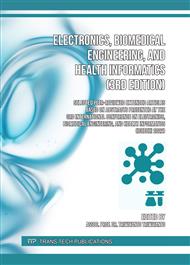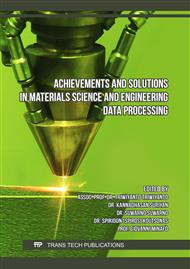[1]
K. Somasundaram and P. Kalavathi, Analysis of Imaging Artifacts in MR Brain Images,, Orient. J. Comput. Sci. …, vol. 5 N0 1, p.135–141, 2012, [Online]. Available: http://computerscijournal.org/dnload/Somasundaram-K-and-Kalavathi-P-/OJCSV05I01P135-141.pdf.
Google Scholar
[2]
N. Mahmood, A. Shah, A. Waqas, A. Abubakar, S. Kamran, and S. B. Zaidi, Image segmentation methods and edge detection: An application to knee joint articular cartilage edge detection,, J. Theor. Appl. Inf. Technol., vol. 71, no. 1, p.87–96, (2015).
Google Scholar
[3]
M. Zaitsev, J. Maclaren, and M. Herbst, Motion artifacts in MRI: A complex problem with many partial solutions,, J. Magn. Reson. Imaging, vol. 42, no. 4, p.887–901, 2015,.
DOI: 10.1002/jmri.24850
Google Scholar
[4]
R. L. Ehman and J. P. Felmlee, Flow artifact reduction in MRI: A review of the roles of gradient moment nulling and spatial presaturation,, Magn. Reson. Med., vol. 14, no. 2, p.293–307, 1990,.
DOI: 10.1002/mrm.1910140214
Google Scholar
[5]
J. Zhuo and R. P. Gullapalli, MR Artifacts, Safety, and Quality Control,, RadioGraphics, vol. 26, no. 1, p.275–297, 2006,.
DOI: 10.1148/rg.261055134
Google Scholar
[6]
R. Kijowski and G. E. Gold, Routine 3D magnetic resonance imaging of joints,, J. Magn. Reson. Imaging, vol. 33, no. 4, p.758–771, 2011,.
DOI: 10.1002/jmri.22342
Google Scholar
[7]
R. B. Frobell, H. P. Roos, E. M. Roos, F. W. Roemer, J. Ranstam, and L. S. Lohmander, Treatment for acute anterior cruciate ligament tear: Five year outcome of randomised trial,, BMJ, vol. 346, no. 7895, p.1–12, 2013,.
DOI: 10.1136/bmj.f232
Google Scholar
[8]
R. Golfieri, H. Baddeley, J. S. Pringle, and R. Souhami, The role of the STIR sequence in magnetic resonance imaging examination of bone tumours,, Br. J. Radiol., vol. 63, no. 748, p.251–256, 1990,.
DOI: 10.1259/0007-1285-63-748-251
Google Scholar
[9]
M. J. Sampson, M. P. Jackson, C. J. Moran, R. Moran, S. J. Eustace, and S. Shine, Three Tesla MRI for the diagnosis of meniscal and anterior cruciate ligament pathology: a comparison to arthroscopic findings,, Clin. Radiol., vol. 63, no. 10, p.1106–1111, 2008,.
DOI: 10.1016/j.crad.2008.04.008
Google Scholar
[10]
S. Särkka and A. Solin, Filtering of Physiological Noise: DRIFTER,, vol. 60, no. 2, p.1517–1527, 2012,.
Google Scholar
[11]
K. S.Tamilselvan, G. Murugesan, and M. Vinothsaravanan, A Histogram based Hybrid Approach for Medical Image Denoising using Wavelet and Curvelet Transforms,, Int. J. Comput. Appl., vol. 74, no. 21, p.6–11, 2013,.
DOI: 10.5120/13040-0053
Google Scholar
[12]
M. Athans, Kalman filtering,, Control Syst. Handb. Control Syst. Adv. Methods, Second Ed., no. June, p.295–306, 2010,.
Google Scholar
[13]
X. Feng, M. Salerno, C. M. Kramer, and C. H. Meyer, Kalman filter techniques for accelerated Cartesian dynamic cardiac imaging,, Magn. Reson. Med., vol. 69, no. 5, p.1346–1356, 2013,.
DOI: 10.1002/mrm.24375
Google Scholar
[14]
D. W. Kim, C. Kim, D. H. Kim, and D. H. Lim, Rician nonlocal means denoising for MR images using nonparametric principal component analysis,, EURASIP J. Image Video Process., vol. 2011, no. 1, p.1–8, 2011,.
DOI: 10.1186/1687-5281-2011-15
Google Scholar
[15]
J. Shin, S. Ahn, and X. Hu, Correction for the T1 effect incorporating flip angle estimated by Kalman filter in cardiac-gated functional MRI,, Magn. Reson. Med., vol. 70, no. 6, p.1626–1633, 2013,.
DOI: 10.1002/mrm.24620
Google Scholar
[16]
S. Sharifzadeh Javidi and H. Saligheh Rad, Using Kalman Filter to Improve the Accuracy of Diffusion Coefficients in MR Imaging: A Simulation Study,, Iran. J. Radiol., vol. 16, no. Special Issue, p.1–2, 2019,.
DOI: 10.5812/iranjradiol.99153
Google Scholar
[17]
E. A. Moore, M. J. Graves, and M. R. Prince, From Picture to Proton,, (1997).
Google Scholar
[18]
M. Gupta, H. Taneja, L. Chand, and V. Goyal, Enhancement and analysis in MRI image denoising for different filtering techniques,, J. Stat. Manag. Syst., vol. 21, no. 4, p.561–568, 2018,.
DOI: 10.1080/09720510.2018.1466964
Google Scholar
[19]
Z. Q. Abdullah, Quality assessment on medical image denoising algorithm: diffusion and wavelet transform filters,, no. April, (2014).
Google Scholar
[20]
F. Baselice, G. Ferraioli, and V. Pascazio, A 3D MRI denoising algorithm based on Bayesian theory,, Biomed. Eng. Online, vol. 16, no. 1, p.1–19, 2017,.
DOI: 10.1186/s12938-017-0319-x
Google Scholar
[21]
D. Hernando et al., Removal of olefinic fat chemical shift artifact in diffusion MRI,, Magn. Reson. Med., vol. 65, no. 3, p.692–701, 2011,.
DOI: 10.1002/mrm.22670
Google Scholar
[22]
E. M. Bellon, E. M. Haacke, P. E. Coleman, D. A. Steiger, and E. Gangarosa, MR Artifacts :,, (1986).
Google Scholar
[23]
Y. Wang, Y. Song, H. Xie, W. Li, B. Hu, and G. Yang, Reduction of Gibbs artifacts in magnetic resonance imaging based on Convolutional Neural Network,, Proc. - 2017 10th Int. Congr. Image Signal Process. Biomed. Eng. Informatics, CISP-BMEI 2017, vol. 2018-January, no. October, p.1–5, 2018,.
DOI: 10.1109/cisp-bmei.2017.8302197
Google Scholar
[24]
C. Zhao et al., HHS Public Access,, p.132–141, 2020,.
Google Scholar
[25]
F. Shuaib, D. Kimbrough, M. Roofe, G. McGwin Jr, and P. Jolly, 基因的改变NIH Public Access,, Bone, vol. 23, no. 1, p.1–7, 2008,.
Google Scholar
[26]
D. A. Steinman and B. K. Rutt, On the nature and reduction of plaque-mimicking flow artifacts in black blood MRI of the carotid bifurcation,, Magn. Reson. Med., vol. 39, no. 4, p.635–641, 1998,.
DOI: 10.1002/mrm.1910390417
Google Scholar
[27]
J. Olsrud, J. Lätt, S. Brockstedt, B. Romner, and I. M. Björkman-Burtscher, Magnetic resonance imaging artifacts caused by aneurysm clips and shunt valves: Dependence on field strength (1.5 and 3 T) and imaging parameters,, J. Magn. Reson. Imaging, vol. 22, no. 3, p.433–437, 2005,.
DOI: 10.1002/jmri.20391
Google Scholar
[28]
Y. Hirokawa, H. Isoda, Y. S. Maetani, S. Arizono, K. Shimada, and K. Togashi, MRI artifact reduction and quality improvement in the upper abdomen with PROPELLER and Prospective Acquisition Correction (PACE) technique,, Am. J. Roentgenol., vol. 191, no. 4, p.1154–1158, 2008,.
DOI: 10.2214/ajr.07.3657
Google Scholar
[29]
D. Tamada, M. L. Kromrey, S. Ichikawa, H. Onishi, and U. Motosugi, Motion artifact reduction using a convolutional neural network for dynamic contrast enhanced mr imaging of the liver,, Magn. Reson. Med. Sci., vol. 19, no. 1, p.64–76, 2020,.
DOI: 10.2463/mrms.mp.2018-0156
Google Scholar
[30]
T. B. Smith and K. S. Nayak, MRI artifacts and correction strategies,, Imaging Med., vol. 2, no. 4, p.445–457, 2010,.
Google Scholar
[31]
A. Yoshikawa et al., Heart Rate and Respiration Affect the Functional Connectivity of Default Mode Network in Resting-State Functional Magnetic Resonance Imaging,, Front. Neurosci., vol. 14, no. June, p.1–13, 2020,.
DOI: 10.3389/fnins.2020.00631
Google Scholar
[32]
B. F. Lane, F. Q. Vandermeer, R. C. Oz, E. W. Irwin, A. B. McMillan, and J. J. Wong-You-Cheong, Comparison of sagittal T2-weighted BLADE and fast spin-echo MRI of the female pelvis for motion artifact and lesion detection,, Am. J. Roentgenol., vol. 197, no. 2, p.307–313, 2011,.
DOI: 10.2214/ajr.10.5918
Google Scholar
[33]
K. Krupa and M. Bekiesińska-Figatowska, Artifacts in magnetic resonance imaging,, Polish J. Radiol., vol. 80, no. 1, p.93–106, 2015,.
DOI: 10.12659/pjr.892628
Google Scholar
[34]
Y. Zhao et al., Localized Motion Artifact Reduction on Brain MRI Using Deep Learning with Effective Data Augmentation Techniques,, Proc. Int. Jt. Conf. Neural Networks, vol. 2021-July, 2021,.
DOI: 10.1109/ijcnn52387.2021.9534191
Google Scholar
[35]
B. Chen, L. Zhang, H. Chen, K. Liang, and X. Chen, A novel extended Kalman filter with support vector machine based method for the automatic diagnosis and segmentation of brain tumors,, Comput. Methods Programs Biomed., vol. 200, p.105797, 2021,.
DOI: 10.1016/j.cmpb.2020.105797
Google Scholar
[36]
R. M. Chen, S. C. Yang, and C. M. Wang, MRI brain tissue classification using unsupervised optimized extenics-based methods,, Comput. Electr. Eng., vol. 58, p.489–501, 2017,.
DOI: 10.1016/j.compeleceng.2017.01.018
Google Scholar
[37]
P. Spincemaille, T. D. Nguyen, M. R. Prince, and Y. Wang, Kalman filtering for real-time navigator processing,, Magn. Reson. Med., vol. 60, no. 1, p.158–168, 2008,.
DOI: 10.1002/mrm.21649
Google Scholar
[38]
S. C. Yang et al., Contrast enhancement and tissues classification of breast MRI using Kalman filter-based linear mixing method,, Comput. Med. Imaging Graph., vol. 33, no. 3, p.187–196, 2009,.
DOI: 10.1016/j.compmedimag.2008.12.001
Google Scholar
[39]
C. M. Wang, G. C. Lin, C. Y. Lin, and R. M. Chen, An unsupervised Kalman filter-based linear mixing approach to MRI classification,, IEEE Asia-Pacific Conf. Circuits Syst. Proceedings, APCCAS, vol. 2, p.1105–1108, 2004,.
DOI: 10.1109/apccas.2004.1413077
Google Scholar
[40]
X. Li, Y. H. Lee, S. Mikaiel, J. Simonelli, T. C. Tsao, and H. H. Wu, Respiratory motion prediction using fusion-based multi-rate kalman filtering and real-time golden-angle radial mri,, IEEE Trans. Biomed. Eng., vol. 67, no. 6, p.1727–1738, 2020,.
DOI: 10.1109/tbme.2019.2944803
Google Scholar



